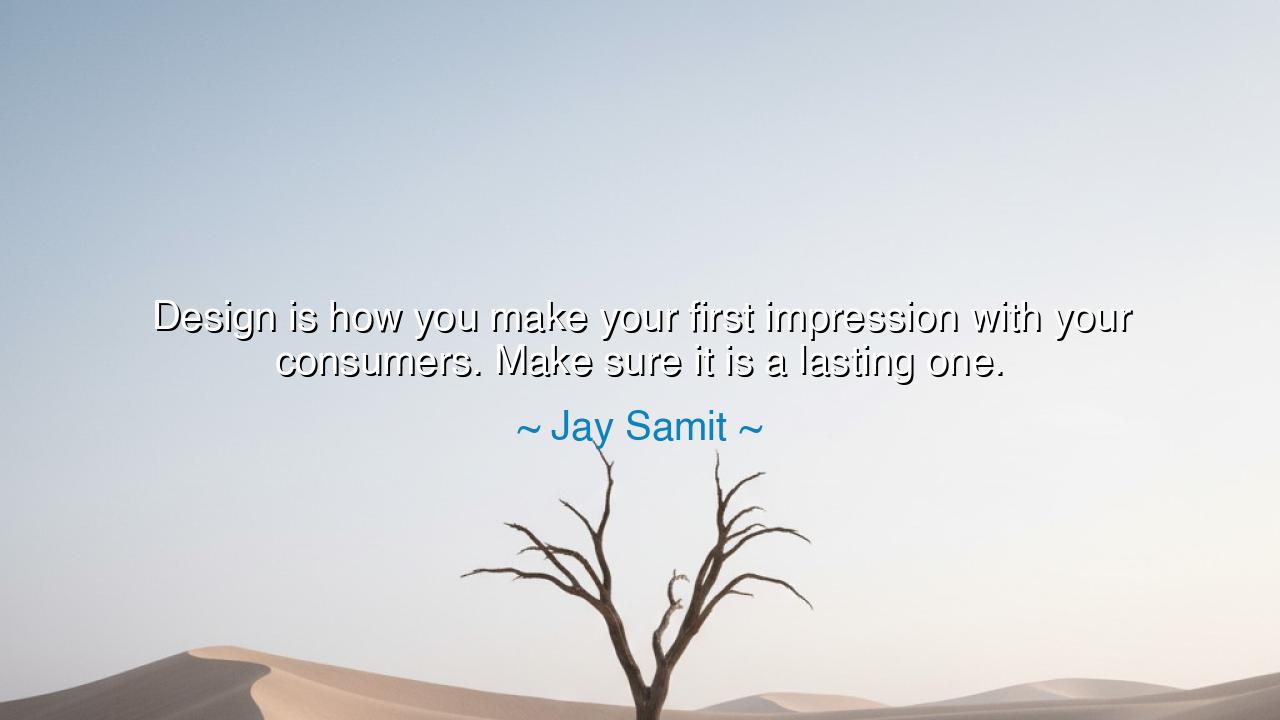
Design is how you make your first impression with your consumers.
Design is how you make your first impression with your consumers. Make sure it is a lasting one.






When Jay Samit declared, “Design is how you make your first impression with your consumers. Make sure it is a lasting one,” he spoke not merely of aesthetics, but of the power of perception and trust. His words remind us that design is the silent ambassador of intention — the first handshake, the first smile, the first note of a story told without words. It is the herald of identity, speaking to hearts and minds before a single explanation is given. In Samit’s vision, every creation, from a product to a service, is a messenger, and its design determines whether that message resonates or falters.
The origin of this insight arises from Samit’s decades of experience as an innovator and entrepreneur, navigating the currents of business in a world flooded with choice and distraction. He observed that consumers judge, decide, and remember not only by function, but by the impression a design leaves. A product’s elegance, its clarity, its intuitive grace can forge trust, loyalty, and desire in the hearts of those who encounter it. Conversely, poor design communicates carelessness, doubt, and fleeting value. The first impression is not trivial; it is the seed from which relationships, reputations, and commerce grow.
Samit’s wisdom echoes the timeless lesson of the ancients: that first encounters shape destiny. In the courts of kings and emperors, the bearing of a diplomat, the polish of a scroll, or the arrangement of gifts could seal alliances or ignite distrust. The Roman orator knew that the opening phrase of speech determined the ears that would hear, the minds that would judge. Similarly, in design, the first encounter — whether with a product, a building, or a visual identity — sets the stage for all that follows. It is the moment when attention is claimed, curiosity awakened, and confidence established.
Consider the story of Apple and the launch of the first iPhone. Its design was not merely functional; it was intuitive, elegant, and precise. The world marveled not only at its capabilities, but at the clarity of its vision. That first impression — the smooth glass, the minimalist interface, the elegance of interaction — created a lasting emotional imprint, cementing Apple’s reputation for innovation. Every user who first touched the device understood, without explanation, that this was not a product of compromise, but of vision and care. Samit’s point is proven here: design is the bridge between intention and perception.
The meaning of his quote extends beyond products into the realm of ideas, experiences, and leadership. A business, a presentation, or even a gesture carries design within it. The arrangement of words, the selection of tone, the structure of interaction — these are all forms of design. The first impression is the lens through which everything else is interpreted, and its lasting effect shapes belief, memory, and behavior. A well-crafted introduction can inspire trust and admiration; a careless one can cast shadows that linger indefinitely.
Samit’s observation is also a call to consciousness and care. To design well is to acknowledge responsibility: that each detail, from color to layout, from ergonomics to narrative, contributes to a whole that speaks of competence, integrity, and respect. Poor design, by contrast, is not neutral — it communicates disregard. The maker, like the ancient artisan, must consider the eyes, hands, and hearts of those who will encounter the creation. Design is an act of ethical stewardship, a silent dialogue between creator and consumer that can endure for years.
O listener, take this teaching into your hands: craft every first impression with intention and precision. Whether you design a product, a workspace, a message, or even your own persona, remember that the opening encounter shapes lasting judgment. Observe carefully, choose deliberately, and let every line, color, and action convey clarity and care. In doing so, you transform the ephemeral moment of introduction into a lasting covenant of trust, admiration, and connection.
In the end, Jay Samit reminds us that design is the language of first impressions, and first impressions are the architects of legacy. To neglect it is to leave destiny to chance; to honor it is to build bridges of understanding, loyalty, and respect that endure far beyond the initial glance. Let every creation speak not only to function, but to soul — so that when the first impression is made, it resonates, endures, and becomes a memory that elevates all who encounter it.






AAdministratorAdministrator
Welcome, honored guests. Please leave a comment, we will respond soon